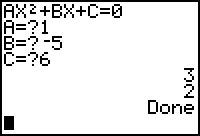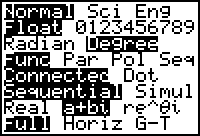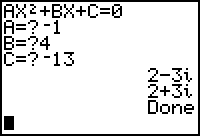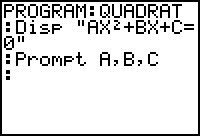Thank you for visiting our site! You landed on this page because you entered a search term similar to this: factor calculator for a quadratic equation, here's the result:
| → Quadratic Equations | revised Jan 25, 2004 |
Quadratic Equations on the TI-83/84
, Oak Road Systems
Summary: You can program your TI-83/84 to solve quadratic equations, and this page shows you the procedure. Though you need to know how to solve quadratics by the methods taught in class, the program is a great way to check your work for accuracy.
The Program
The program below solves a quadratic equation whether it has real roots or not.
If you have the TI Graph Link software, you can download the program from this ZIP file (1 KB), unzip it to any convenient directory, and download it to your TI-83/84.
Otherwise, you can enter the program manually. If you're not familiar with TI-83/84 programming instructions, please see the keystroke procedure in the Entering the Program, below.
Disp "AX²+BX+C=0" Prompt A,B,C B²-4AC→D Disp (-B+√(D))/(2A) Disp (-B−√(D))/(2A) DelVar A DelVar B DelVar C DelVar D
Running the Program
To run the program, press [PRGM]. Look at the list of programs and press the appropriate number; or scroll to the program and press [ENTER]. The program name will appear on your screen. Press [ENTER] to run it.
 Example: you know that x²−5x+6 = 0 factors as
(x−2)(x−3) = 0, and therefore the roots are
2 and 3. Run the program with A=1, B=−5, C=6. (Be careful to use
the change-sign key [(-)] and not the minus key
[-].) The answers 2 and 3 are produced, as expected.
Example: you know that x²−5x+6 = 0 factors as
(x−2)(x−3) = 0, and therefore the roots are
2 and 3. Run the program with A=1, B=−5, C=6. (Be careful to use
the change-sign key [(-)] and not the minus key
[-].) The answers 2 and 3 are produced, as expected.
Example: 25x²−20x = −4. First put it in standard form, 25x²−20x+4 = 0. Now run the program with A=25, B=−20, C=4. You see roots of .4 and .4, a double root of 2/5. This makes sense because the equation factors as (5x−2)² = 0.
Try additional examples using the equations in your textbook. Remember that the calculator program is intended for checking your calculations; you'll still be expected to solve quadratic equations manually in class and in homework.
Complex Roots
 If you get the message "NONREAL ANS" when running the program, it
means your equation has no real roots but your calculator is in
real-only mode. Select 1:Quit.
You can set up your calculator to view non-real roots, as follows:
If you get the message "NONREAL ANS" when running the program, it
means your equation has no real roots but your calculator is in
real-only mode. Select 1:Quit.
You can set up your calculator to view non-real roots, as follows:
You want to select a+bi mode.
 |
Press [MODE] [ Return to the home screen with [2nd] [QUIT]. |
You can now run the program again to view the non-real roots. The calculator remembers a+bi mode, like all modes, even when turned off.
 Example: −x²+4x = 13. First put the equation in
standard form: −x²+4x−13 = 0. Then run
the QUADRAT program with A=−1, B=4, C=−13 to find the
roots 2±3i.
Example: −x²+4x = 13. First put the equation in
standard form: −x²+4x−13 = 0. Then run
the QUADRAT program with A=−1, B=4, C=−13 to find the
roots 2±3i.
Entering the Program
Programming the TI-83/84 isn't hard, but it does use a bunch of keys and menus you might not be familiar with. The following procedure is a lot shorter than it looks, because it doesn't just tell you what to enter but helps you find the "shifted" keys.
You do need to do things exactly as shown. In particular, some people have the habit of pressing the [2nd] key before every unusual operation. Don't press the [2nd] or [ALPHA] key unless the instructions tell you to, and do be careful not to use one in place of the other.
I recommend ticking off each step with a pencil as you do it, so that you don't get lost.
| Open the Program Editor for a new program. | [PRGM] [ |
| Enter a name for the new program, such as QUADRAT. | You're already in alpha mode. Use the little green letters, and press [ENTER] when finished. |
| optional:
Any good program should give some idea what it's doing. This
one-line comment should be instantly recognizable to anyone
who has studied quadratic equations. The line you are creating is
Disp "AX²+BX+C=0" However, if you want to leave out this documentation step the program will still run. |
For Disp, press [PRGM] [ Locate the double quote in green above the [+] key, and press [ALPHA] ["]. Locate the green A above the [MATH] key. Press [ALPHA] [A] [x,T,θ,n] [x²] [+]. Locate the green B above the [APPS] key. Press [ALPHA] [B] [x,T,θ,n] [+]. Locate the green C above the [PRGM] key. Press [ALPHA] [C] [x,T,θ,n]. For the = sign, locate the yellow TEST above the [MATH] key. (Note: yellow, not green!) Press [2nd] [TEST] [1], then finish the command with [0] [ALPHA] ["] [ENTER]. Notice that the command wraps automatically to the next line. |
Now program the instructions to ask for the coefficients
A, B, and C.

|
For Prompt, press [PRGM] [ You already found the green letters starting above the [MATH key, and the comma is a key of its own, one row above the [7] key. To complete this command, press [ALPHA] [A] [,] [ALPHA] [B] [,] [ALPHA] [C] [ENTER] |